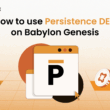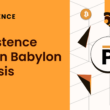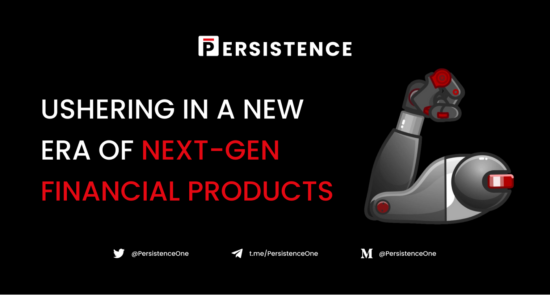Note: Persistence has pivoted to liquid staking and building DeFi primitives to increase the utility for staked assets. This article is only for archive purposes.
(Visit here to read our latest blogs)
The Internet disintermediated the media & communications industry. Using HTTP, SMTP, and TCP/IP as the foundational layers, the cost of information exchange was significantly lowered.
Data flows like water today.
Persistence is leveraging blockchain technology to facilitate seamless asset exchange. Using Web 3.0 protocols, Persistence is providing the infrastructure for the creation of a suite of bleeding edge financial products ranging from NFT marketplaces and tokenized ‘real-world’ debt trading platforms to staking-as-a-service infrastructure.
Digital assets will flow like water tomorrow.
We’ve come a long way on our journey to usher in this new financial paradigm since Persistence began as a concept in 2018.
Our progress so far, however, is just the tip of the iceberg when it comes to what Persistence has in store. In this article we will provide an overview of Persistence and introduce you to some of the exciting ecosystem products which we’re currently working on bringing to fruition.
Persistence: An Overview
Persistence is an interoperable protocol built to facilitate the creation of next-gen financial products. The Persistence tech stack provides the infrastructure to effectively bridge the realms of DeFi and traditional finance in a variety of areas, whilst also enabling the creation of innovative crypto-facing solutions to expand the DeFi and NFT sectors.
Using the features of DeFi and utilizing NFTs to tokenize real-world assets can solve the current problems of traditional finance, thus opening the floodgates to allow a torrent of new capital into the crypto ecosystem.
In addition, Persistence’s interoperable infrastructure provides the means to create an endless array of cutting-edge crypto-facing products which can offer unique opportunities within DeFi and the NFT space that have never before been seen in the blockchain industry.
Tech Stack
The Persistence Software Development Kit (SDK) is a set of standardized modules that can be used to model marketplaces for the easy exchange of value. Modules of the SDK can be integrated into existing applications. Alternatively, the modules can be used in different permutations and combinations to spin up entirely new marketplaces.
Essentially, our tech stack is designed to accommodate four important factors:
- Accessibility — Bringing physical commodities on-chain as NFTs.
- Liquidity — Opening up untapped liquidity in the crypto space for MSME businesses.
- Sustainability — Bringing crypto beyond speculation with real-world use cases and a “work-token” that becomes the foundation for sustainable income.
- Innovation — Enabling the creation of cutting-edge crypto-facing products focused on interoperability to provide new opportunities for the crypto community.
Let’s dive into some of the products and services currently live and coming soon to the Persistence ecosystem.
Comdex, an institutional-facing commodities trading and trade financing platform, is the flagship DApp in the Persistence ecosystem.
On the product side, the Persistence team began with a focus on the commodity trading industry. The commodity trading industry is very archaic and exclusive, mainly due to the limited avenues to create auditability, ensure trust and provide liquidity. Comdex solves these issues through blockchain integration and is already gaining traction, having handled over $55M in transaction volume so far — bringing more assets on chain than its (longer-established) competitors combined.
Our team partnered with commodity trading entrepreneurs in Singapore who were working on creating a marketplace for commodity traders called Comdex. Our go-to-market strategy is working with family offices and SME organizations which utilize their business networks to drive adoption.
pLend is a stablecoin lending platform backed by real-world assets (such as invoices). It will enable stablecoin holders to supply liquidity to pools to support operations on Comdex, thereby producing returns for stablecoin holders from real-world income generating assets.
pLend will allow stablecoin holders to seamlessly participate in the $65B global trade financing industry. This is a huge leap towards the bridging of traditional finance (TradFi) and DeFi. No longer will stablecoin holders need to rely on precarious new DeFi protocols to generate attractive returns on their assets; they will now be able to tap into a reliable and lucrative industry as old as trade itself.
AUDIT.one is a subsidiary of Persistence.one which provides top-tier validation services for leading PoS networks by utilizing highly secure Tier 3 and Tier 4 data centers across multiple geographical locations clubbed with a multi-cloud architecture.
We initially established AUDIT.one in Q2 of 2020 as one of the validators for the Persistence ecosystem. However, as we grew Persistence, we identified several key areas in which AUDIT.one could not only help Persistence’s chain but also the broader PoS network ecosystem as a whole. Our validation infrastructure is quickly becoming an integral component of the broader PoS ecosystem.
AUDIT.one currently has over $120M in assets under management across nine networks (Cosmos, Terra, Matic Network, NEAR, IRIS, Kava, Skale, Marlin, and Celo) with support for further networks underway. These include Polkadot, Tezos and Ethereum 2.0.
Bringing Staking to Institutions
In a major move toward bridging the traditional financial space and crypto, we’re now also bringing crypto-focused products to institutions by whitelabeling our validation service. Our first partner in this regard is Tavis Digital, a billion-dollar asset manager based in Switzerland. By utilizing our AUIDT.one infrastructure under their own brand, Tavis Digital will be able to offer institutional players a secure and reliable solution for crypto asset staking.
This will pave the way for the introduction of PoS assets as an asset class for institutions. In a world of zero interest rates, we believe this will be received very positively. We’re excited to be spearheading this next wave of institutional adoption!
There is a huge demand for additional yield generation from staked assets. The interest in our ongoing StakeDrop campaigns is testament to this. In order to address this demand, we’re creating pStake. pStake is essentially a liquid staking product similar to Lido. The difference? Interoperability.
Though there are many up-and-coming chains poised to play a major role in the decentralized revolution, the vast majority of cryptocurrency liquidity and the most attractive DeFi opportunities currently reside on the Ethereum network. There are few to no options available for stakers of native PoS tokens to unlock liquidity for their staked assets, and even if they could, there are few opportunities for additional yield generation on many chains with DeFi ecosystems yet to flourish. pStake solves both of these issues.
Let’s take ATOM as an example, since we are beginning pStake with the Cosmos Hub chain. Traditionally, once an ATOM holder stakes their tokens, their ATOMs are illiquid. Not with pStake. pStake will allow the issuance of representative tokens (stkTokens) on Ethereum which are backed 1:1 by those staked assets. By doing so, illiquid staked ATOMs can be converted to liquid representative ERC20 tokens that can be utilized within the vast DeFi ecosystem on Ethereum.
This will allow PoS token stakers to take advantage of a wide range of yield generation opportunities currently inaccessible to them. For example, staked ATOMS (represented as pATOMs) can now be utilized as collateral to borrow other crypto assets (e.g. stablecoins), which can then be used for various financial strategies.
Though pStake will initially be launched with support for Cosmos (ATOM), we will gradually expand support to other major PoS chains. The sky’s the limit.
When ATOMs (and other PoS tokens supported moving forward) are staked via pStake, a percentage of those tokens will be staked via our AUDIT.one validator. Thus, as pStake grows, so will AUDIT.one.
Asset Mantle is a framework for NFT marketplaces. As a framework, Asset Mantle will provide all of the elements required to create individual marketplaces. It will also facilitate the creation (minting) of interoperable NFTs which can flow between different blockchains. Asset Mantle can support all manner of NFTs, ranging from digital art and collectibles to tokenized tickets.
Niche-Specific Marketplaces
Unlike other similar platforms such as OpenSea and SuperRare (which are consolidated/agnostic marketplaces), Asset Mantle will allow the creation of dedicated marketplaces for selections of products from specific sellers or groups of sellers.
Though Asset Mantle is also perfect for creating agnostic marketplaces, its unique value proposition is that anyone will be able to create their own marketplaces. Think of it as ‘Shopify for NFTs’; instead of listing products on an ‘Amazon for NFTs’ (such as OpenSea), entrepreneurs and artists will be able to create their own Shopify-style stores for their specific NFT assets.
Interoperability
A major problem with current NFT marketplaces is that they are very centric to Ethereum. As the broader crypto ecosystem continues to expand, the need for assets that can flow between different ecosystems is becoming increasingly important. Asset Mantle is the solution.
Asset Mantle is a by-product of our interNFT initiative. Since the platform uses the interNFT module in the background, NFTs created via Asset Mantle will be interoperable, thus able to convert between the ERC-721 standard and other native NFT standards on different chains; essentially free to flow between different blockchains (for example from Cosmos to Ethereum).
We are working with other innovators within the Cosmos ecosystem to bring Asset Mantle to fruition. The development of Asset Mantle is well underway, with a prototype product already live. Expect to hear more about Asset Mantle in the coming weeks and months!
The Role of XPRT
XPRT will carry a variety of use cases within the Persistence ecosystem, including participating in staking to contribute to network security, and community governance of the Persistence mainchain.
As a ‘work’ token, XPRT will also accrue value in direct correlation to increased financial activity within Persistence’s ecosystem dApps. Essentially, dApps on Persistence conduct business and fees trickle down to the mainchain, bringing additional value for XPRT token holders — in direct correlation to the value being processed and exchanged.
XPRT will be distributed at the Persistence TGE (tentatively projected late Q1 of 2021) as an ERC-20 token. Later, once the Persistence mainnet is launched, it will be swapped for the native mainnet coin.
Onward to a New Financial Paradigm
“At Persistence we’ve always been guided by our forward-thinking vision, as illustrated by our focus on real-world assets, NFTs, and interoperability. Our progress in 2020 has laid the groundwork for us to create a complete ecosystem of financial products catering to both institutional and crypto-native users.”
– Tushar Aggarwal, Co-founder and CEO of Persistence
The products we’ve laid out above are just a taste of what’s in store for Persistence and our ecosystem. We’re working to reach new heights in blockchain interoperability, bridging TradFi with DeFi through NFTs, creating new opportunities for the crypto community, and much more.
With our public sale and TGE around the corner and innovation in the Persistence ecosystem accelerating, 2021 is shaping up to be a monumental year for Persistence and the blockchain industry as a whole.
Thank you for championing new financial frontiers with us as we BUIDL Persistence. Strap in for a very exciting year ahead!
About Persistence
Persistence is a Tendermint-based, specialised Layer-1 network powering an ecosystem of DeFi applications focused on unlocking the liquidity of staked assets.
The Persistence chain facilitates the issuance and deployment of liquid-staked stkASSETs, allowing users to earn staking rewards while participating in DeFi primitives, such as lending/borrowing and liquidity provisioning on DEXs.
Persistence aims to offer a seamless staking and DeFi experience for PoS (Proof-of-Stake) users and enable developers to build innovative applications around stkASSETs.
Join Our Movement
Twitter | LinkedIn | Telegram | YouTube | Reddit | [email protected]





